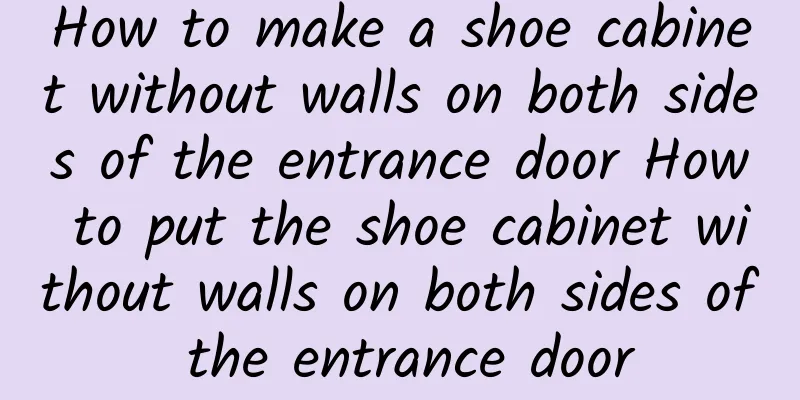How to make a shoe cabinet without walls on both sides of the entrance door How to put the shoe cabinet without walls on both sides of the entrance door

|
We all know that shoe cabinets are a common design in the home, and almost all families have shoe cabinets. There are many ways to design and decorate shoe cabinets, and different houses and different layouts will have different design plans. So how to design a shoe cabinet if there are no walls on the left and right of the entrance door? Let's take a closer look! How to make a shoe cabinet without a wall at the entrance doorFirst: Customize storage cabinets along the wallFor a living room and dining room that is right at the entrance, you can divide a part of the living room background wall into sections and place storage cabinets, one group or one, to meet the needs of the user and the style of the space. When customizing, you can use floor-to-ceiling, closed cabinets to enhance the functionality of the space. Second: Build a porch wallIf there is no porch at the entrance door, you can build a porch as a transition without affecting the overall apartment. Design a partition wall between the entrance door and the living room area, and then make a built-in cabinet. This will not affect the overall design, but can ensure a certain degree of privacy and aesthetics. It is a good choice. Third: Place the shoe cabinet directlyAt the entrance, you can directly customize a large cabinet and place it between the entrance door and the living room, or between the entrance door and the dining room. This problem can be solved by a beautiful design and a simple modification of the appearance and surrounding environment. How to arrange the shoe cabinet1. One-line typeThe one-line shape is to place the shoe cabinet next to the entrance wall, close to the wall, to reduce the area occupied by the living room and dining room. Without affecting the lighting, the shoe cabinet can be used to create a comfortable entrance out of thin air. Its light, ventilation and area will not change much, which is suitable for small apartments. 2. Type IType I placement means that the shoe cabinet is perpendicular to the entrance wall, which visually presents a vertical form. It can be separated from the open living and dining room layout, effectively dividing each functional area, and will not have much impact on lighting and ventilation. It is suitable for most house types. 3. Inverted L-ShapeThe inverted L-shaped design is also called the screen wall design. This is to add a vertical wall next to the entrance door, and place the shoe cabinet opposite the door to form a simple and elegant entrance area. The space is wider and more comfortable, increasing the design space and the storage area, which is suitable for households with a large population. However, this design method is easy to affect lighting and ventilation, and additional lights need to be added to avoid dim light and affect the overall appearance. Shoe cabinet sizeThe standard width of a traditional shoe cabinet is 1.2M. If the entrance area is larger than 2M, the width of the shoe cabinet should be greater than 1.1M. The conventional size of a shoe cabinet is 2M×1.2M. The dimensions of a shoe cabinet are divided into depth, width and length, which are determined according to the style of the shoe cabinet. For a conventional shoe cabinet, considering the length of men's and women's shoes, the depth is best within 350-400mm. If you are used to placing shoe boxes in the shoe cabinet, you should increase the distance by 30mm, that is, within 380-400mm. General shoe cabinets have upper and lower layers, with a spacing of 160MM between the upper and lower layers. Taking into account that shoes are longer in winter, 32MM adjustable layers can be added to the side panels of the shoe cabinet to facilitate seasonal use. The specific number needs to be determined based on the needs of the residents. Shoe cabinet style1. ClassicClassic styles never lose value due to time and aesthetic changes. Classic shoe cabinets are independent cabinets with hinged doors on the outside. They can be placed directly in any corner of the interior space and are highly adaptable. The internal structure of the shoe cabinet is simple, usually with two to three layers, without complicated lace and structure, but its capacity is insufficient and its plasticity is low, so it is necessary to purchase a separate storage shoe cabinet. 2. Stand tall and uprightThe floor-to-ceiling style means that the height of the shoe cabinet is flush with the ceiling, with no extra gaps, to avoid the accumulation of dust and debris, and to provide convenience for the residents' lives. The overall look of the floor-to-ceiling style is more comfortable and natural, and it can accommodate more things, which is very popular among people. 3. Leave the middle blankThe middle part is left empty on the basis of the whole-body shoe cabinet, with a 30~50MM shelf reserved in the middle for storing small items such as keys and bags, or decorations such as green plants and photo frames. This design is obtained by observing the daily life of the residents. 4. Leave the bottom blankThe bottom is suspended, which means that 100~150mm of space is reserved under the shoe cabinet for storing frequently used shoes. This avoids the need to store and retrieve the shoe cabinet, saving residents' time and improving the efficiency of entering and leaving the door. 5. Open partitionThe open partition has cabinets on the top and bottom, and enough design space is reserved in the middle for use. Hooks can be added to store coats, bags, etc., or shoe cushions can be added underneath to form a design that integrates a shoe cabinet, shoe bench, and hooks to meet most of people's needs for the entrance. Shoe cabinet colorIn the interior space, color plays a pivotal role and has the function of changing the temperament of the space. The shoe cabinet is an important piece of furniture in the entrance hall, and the choice of its color can affect the style and atmosphere of the entrance hall. 1. WhiteThe classic and versatile white is loved by people in all fields. People give high praise to white for its purity, cleanliness and freshness. White shoe cabinets have always existed. They can perfectly blend with white walls without affecting the overall effect. As a background color, they can highlight the advantages of other home furnishings. 2. Wood colorNatural wood color is present in almost every home. Tables, chairs, wooden floors, etc. are all natural wood color, retaining the texture and veins of natural trees. When placed in the interior space, it invisibly creates the charm of nature. The freshness and naturalness it exudes can relieve people's tension and stress. 3. BlackBlack and white are both classic colors. Unlike white, black has a darker brightness, like an abyss that you can never forget. However, the black shoe cabinet reveals a deep, quiet and high-end feeling, which can enhance the style and temperament of the entrance. The three-dimensional black low shoe cabinet, with its compact appearance and exquisite layout, creates a comfortable picture. Tips for shoe cabinet design1. Lighting design. Adding lights inside the shoe cabinet can not only serve as a supplementary lighting source from the outside, but also highlight the high-end feel of the shoe cabinet. For example, adding a hidden light strip at the bottom of the shoe cabinet makes it easier to go in and out and change shoes. 2. Hooks. Hooks are often hung directly on the wall to store large pieces of clothing or bags. Hooks with unique shapes and exquisite appearance can not only fill in the blank wall, but also enhance the design sense of the entrance. 3. Decorative hangings. Blank walls are dull and boring, so you may want to use paintings, photos or other objects to decorate the walls to enhance the overall look of the entrance and improve the personal taste and aesthetics of the residents. 4. An adjustable area should be added inside the shoe cabinet, and the shelves can be made retractable to accommodate shoes that change seasons. 5. Before customizing the size of the shoe cabinet, you need to fully consider the storage needs of the entrance, such as the number of shoes, the placement of other items, and daily traffic lines, so that you can plan the shoe cabinet reasonably. |
<<: Why do freshly dug sweet potatoes have eyes? The harm of small insects to sweet potatoes
Recommend
What medicine should I take to stop bleeding during menstruation?
Every woman has her own menstrual regularity. Whe...
How much folic acid should I take every day after pregnancy?
Women during pregnancy should pay attention to st...
How many months after giving birth does menstruation come and how to treat it
The incidence of menstrual problems cannot be und...
Is it normal to have an outward-turned belly button during pregnancy?
Many women find that their belly buttons turn out...
What are the dangers of painless visual abortion?
There are many types of painless abortions. Befor...
Why does my belly swell during my period?
The occurrence of abdominal distension and pain h...
Leucorrhea smell acid
If a woman's leucorrhea has a sour odor, she ...
Brown discharge three months after delivery
Many women will have brown discharge three months...
Smart women should not fall in love in four situations
Don’t say that fools have good luck, that’s just ...
What is the reason for the strong body odor?
For female friends, the hygiene and health of the...
Tight and hard belly in early pregnancy
In the early stages of pregnancy, if you are not ...
What's wrong with manual transmission? Do I need to shift gears when parking with manual transmission?
Manual transmission cars require manual operation...
What car does Ye Luming drive in The Next Stop is Happiness? How much does the same car drive in The Next Stop is Happiness?
What is the brand of the luxury car that Ye Lumin...
Can uterine cavity line separation be restored?
Uterine cavity line separation is also a common g...
Do I need to take confinement after a miscarriage?
The probability of spontaneous abortion in early ...









